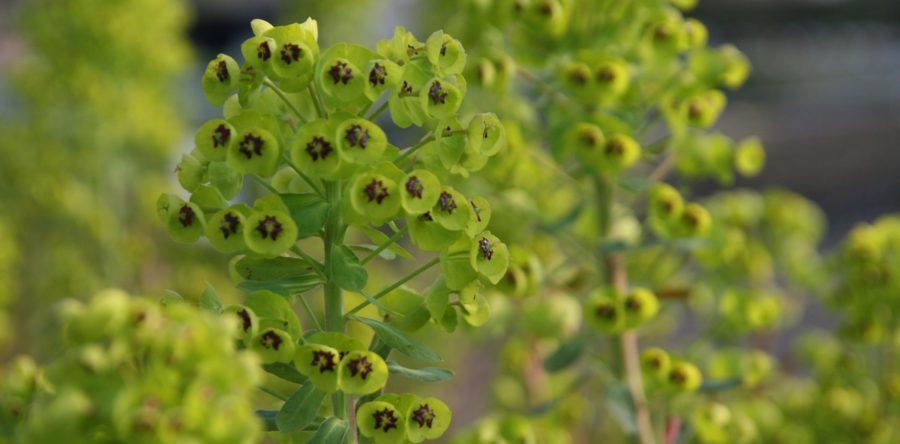 Longing for some long-season interest in your garden? Look no further! Find it here with our August Plant of the Month.
Longing for some long-season interest in your garden? Look no further! Find it here with our August Plant of the Month.
Euphorbia characias 'Black Pearl' is an evergreen perennial with stunning chartreuse "blooms" dotted with dramatically contrasting reddish-black eyes, which sit atop architectural stems full of soft, grey-green foliage. As with all members of the Euphorbiaceae family, the "flowers" we see are actually called cyathia. Each cyathium consists of a cup-shaped involucre containing nectar glands and fused bracts (modified leaves that mimic the appearance of a flower) that surround each inconspicuous true flower. The main flowering season for this plant is summer, but in our mild climate here on the Central Coast, it can be found blooming from early spring through late fall. This spurge is on the smaller size compared to other varieties of the species, reaching only two and a half feet tall and wide at maturity. Although it comes in a modestly-sized package, it packs a powerful punch of color!
Black Pearl Mediterranean Spurge is low-maintenance; to keep the plant looking full and fresh, each stem should be cut back to the base after flowering. New stems will quickly sprout from the base and fill in the gaps. It's as simple as that! Wear gloves and be extremely cautious when working with this (or any) Euphorbia; when wounded, this plant leaks toxic sap. It is also smart to grow this plant only in areas that are free of children and pets.
This fast-growing Mediterranean native thrives in full sun and well-drained soil, but it will tolerate partly-shady conditions and a variety of soil conditions. Due to its succulent foliage and toxic sap, this perennial is considered both drought-tolerant and deer resistant: attributes which increase its popularity in regions where water is scarce and deer are aplenty! The foliage is not easily burned by salt-spray, which also makes it an excellent choice for coastal gardens. Euphorbia 'Black Pearl' is hardy below zero degrees F.
 Use this Euphorbia in borders and mixed perennial beds, or incorporate it into a succulent garden to introduce an interesting new texture. Pair with plants that produce purple, black or burgundy foliage to accentuate the "black pearls" in each flower head. The flowering stems can also be used as a striking element in cut flower arrangements, just be sure to seal the cut ends with an open flame or boiling water for a few seconds first!
Use this Euphorbia in borders and mixed perennial beds, or incorporate it into a succulent garden to introduce an interesting new texture. Pair with plants that produce purple, black or burgundy foliage to accentuate the "black pearls" in each flower head. The flowering stems can also be used as a striking element in cut flower arrangements, just be sure to seal the cut ends with an open flame or boiling water for a few seconds first!



Covid-19 Business Status
All Seasons Landscaping
Covid-19 Business Status
Steve Lake
September Plant of the Month: Leucospermum 'Scarlet Ribbon'
All Seasons Landscaping